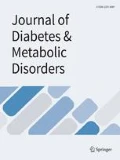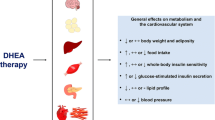Abstract
Purpose
Epidemiological studies show that Anti-mullerian hormone (AMH) is inversely correlated with age, obesity-related diseases, and all-cause mortality in men. To further investigate the role of AMH in aging and obesity, we studied the effect of AMH treatment on the inflammatory and metabolic parameters and weight in old male C57BL/6 mice.
Method
Thirty-six old male C57BL/6 mice (18 month-old) were either on the High-Fat Diet (HFD) or Normal Diet (ND). When obesity occurred in the HFD group, each group was divided into two subgroups; AMH-treated (ND+AMH and HFD+AMH) or controls (ND and HFD). The AMH subgroup received 15 ng/gbw of recombinant AMH injection every 48 h in four weeks. Then, serum AMH, CRP, fasting glucose, fasting insulin, and HOMA-IR were measured and analyzed.
Results
AMH injection decreased CRP level (HFD =622.86±25.73, HFD+AMH =543.2±24.99 ng/ml, p= 0.003), fasting insulin (HFD=1.50± 0.34, HFD+AMH =0.8±0.25 ng/ml, p=0.006) and HOMA-IR (HFD=12.76± 2.88, HFD+AMH =7.06±2.31, p=0.008) in the obese old mice comparison with control. In ND group, just CRP levels dropped following AMH injection (ND=451.24±20.61, ND+AMH= 326.8±23.76 ng/ml; p=0.001). Accelerated weight gain was observed in HFD+AMH compared with the HFD subgroup (p<0.05).
Conclusions
In conclusion, increasing the circulating level of AMH could subside the systemic inflammation through decreasing CRP levels regardless of diet type and enhance insulin sensitivity in old obese mice. It can also lead to higher weight gain, without inflammation, in old obese male mice who are on an HFD.



Similar content being viewed by others
Abbreviations
- AMH:
-
Anti-mullerian hormone
- CRP:
-
C-reactive protein
- HOMA-IR:
-
Homeostatic Model Assessment for Insulin Resistance
- ND:
-
Normal Diet
- HFD:
-
High Fat Diet
- CVD:
-
Cardiovascular Disease
- T2D:
-
Type 2 Diabetes
- SMAD:
-
(Small Mothers against Decapentaplegic homolog)
References
Zamboni M, Mazzali G. Obesity in the elderly: an emerging health issue. Int J Obes. 2012;36:1151–2.
Sarvottam K, Yadav RK. Obesity-related inflammation & cardiovascular disease: efficacy of a yoga-based lifestyle intervention. Indian J Med Res. 2014;139:822.
Ross R. Atherosclerosis--an inflammatory disease. N Engl J Med. 1999;340:115–26.
Coussens LM, Werb Z. Inflammation and cancer. Nature. 2002;420:860–7.
Esposito K, Giugliano D. The metabolic syndrome and inflammation: association or causation? Nutr Metab Cardiovasc Dis. 2004;14:228–32.
Schmid-Schönbein GW, Hugli TE. A new hypothesis for microvascular inflammation in shock and multiorgan failure: self-digestion by pancreatic enzymes. Microcirculation. 2005;12:71–82.
Khan SS, Singer BD, Vaughan DE. Molecular and physiological manifestations and measurement of aging in humans. Aging Cell. 2017;16:624–33.
Hodes RJ, Sierra F, Austad SN, Epel E, Neigh GN, Erlandson KM, et al. Disease drivers of aging. Ann N Y Acad Sci. 2016;1386:45–68.
Ferrucci L, Fabbri E. Inflammageing: chronic inflammation in ageing, cardiovascular disease, and frailty. Nat Rev Cardiol. 2018;15:505–22.
Lee MM, Donahoe PK. Mullerian inhibiting substance: a gonadal hormone with multiple functions. Endocr Rev. 1993;14:152–64.
Taguchi O, Cunha GR, Lawrence WD, Robboy SJ. Timing and irreversibility of Müllerian duct inhibition in the embryonic reproductive tract of the human male. Dev Biol. 1984;106:394–8.
Aksglæde L, Sørensen K, Boas M, Mouritsen A, Hagen C, Jensen RB, et al. Changes in anti-Mullerian hormone (AMH) throughout the life span: a population-based study of 1027 healthy males from birth (cord blood) to the age of 69 years. J Clin Endocrinol Metab. 2010;95:5357–64.
Moolhuijsen LME, Visser JA. Anti-müllerian hormone and ovarian reserve: update on assessing ovarian function. J Clin Endocrinol Metab. 2020;105:3361–73.
Silva MSB, Giacobini P. New insights into anti-müllerian hormone role in the hypothalamic–pituitary–gonadal axis and neuroendocrine development. Cell Mol Life Sci. 2021;78:1–16.
Qayyum R, Akbar S. Serum anti-mullerian hormone and all-cause mortality in men. Endocrine. 2016;54:225–31.
Olszanecka-Glinianowicz M, Madej P, Owczarek A, Chudek J, Skałba P. Circulating anti‐müllerian hormone levels in relation to nutritional status and selected adipokines levels in polycystic ovary syndrome. Clin Endocrinol. 2015;83:98–104.
Herawati S. Anti-Mullerian Hormone (AMH) as a novel marker for ovarian function: a review. Bali Medi J. 2019;8:475–81.
Beydoun HA, Hossain S, Beydoun MA, Weiss J, Zonderman AB, Eid SM. Anti-müllerian hormone levels and cardiometabolic disturbances by weight status among men in the 1999 to 2004 national health and nutrition examination survey. J Endocr Soc. 2019;3:921–36.
Ventimiglia E, Capogrosso P, Colicchia M, Boeri L, Serino A, Castagna G, et al. Metabolic syndrome in white E uropean men presenting for primary couple’s infertility: investigation of the clinical and reproductive burden. Andrology. 2016;4:944–51.
Tehrani FR, Erfani H, Cheraghi L, Tohidi M, Azizi F. Lipid profiles and ovarian reserve status: a longitudinal study. Hum Reprod. 2014;29:2522–9.
Sklavos MM, Zhou CK, Pinto LA, Cook MB. Prediagnostic circulating anti-müllerian hormone concentrations are not associated with prostate cancer risk. Cancer Epidemiol Prev Biomarkers. 2014;23:2597–602.
Dennis NA, Jones GT, Chong YH, van Rij AM, McLennan IS. Serum anti-Mullerian hormone (AMH) levels correlate with infrarenal aortic diameter in healthy older men: is AMH a cardiovascular hormone. J Endocrinol. 2013;219:13–20.
Chong YH, Dennis NA, Connolly MJ, Teh R, Jones GT, van Rij AM, et al. Elderly men have low levels of anti-Müllerian hormone and inhibin B, but with high interpersonal variation: a cross-sectional study of the sertoli cell hormones in 615 community-dwelling men. PloS one. 2013;8:e70967.
Tzeng C-R, Chang Y-cI, Chang Y-c, Wang C-W, Chen C-H, Hsu M-I. Cluster analysis of cardiovascular and metabolic risk factors in women of reproductive age. Fertil Steril. 2014;101:1404–10.
Hoshiya Y, Gupta V, Segev DL, Hoshiya M, Carey JL, Sasur LM, et al. Mullerian inhibiting substance induces NFkB signaling in breast and prostate cancer cells. Mol Cell Endocrinol. 2003;211:43–9.
Lebeurrier N, Launay S, Macrez R, Maubert E, Legros H, Leclerc A, et al. Anti-mullerian-hormone-dependent regulation of the brain serine-protease inhibitor neuroserpin. J Cell Sci. 2008;121:3357–65.
Ricci M, Mohapatra B, Urbiztondo A, Birusingh RJ, Morgado M, Rodriguez MM, et al. Differential changes in TGF-β/BMP signaling pathway in the right ventricular myocardium of newborns with hypoplastic left heart syndrome. J Card Fail. 2010;16:628–34.
Buyukinan M, Atar M, Pirgon O, Kurku H, Erdem SS, Deniz I. Anti-Mullerian hormone and inhibin B levels in obese boys; relations with cardiovascular risk factors. Exp Clin Endocrinol Diabetes. 2018;126:528–33.
Flurkey KCJ, Harrison DE. Mouse models in aging research. In: Fox JG, Davisson MT, Quimby FW, Barthold SW, Newcomer CE, Smith AL, editors. The mouse in biomedical research. Burlington: Academic Press; 2007. pp. 637–72.
Speakman J, Hambly C, Mitchell S, Król E. Animal models of obesity. Obes Rev. 2007;8(Suppl 1):55–61.
Kong HS, Kim SK, Lee J, Youm HW, Lee JR, Suh CS, et al. Effect of exogenous anti-müllerian hormone treatment on cryopreserved and transplanted mouse ovaries. Reprod Sci. 2016;23:51–60.
Sriraman V, Niu E, Matias J, Donahoe PK, MacLaughlin DT, Hardy MP, et al. Müllerian inhibiting substance inhibits testosterone synthesis in adult rats. J Androl. 2001;22:750–8.
Clarke T. Mullerian inhibiting substance signaling uses a bone morphogenetic protein (BMP)-like pathway mediated by ALK2 and induces Smad6 expression. Mol Endocrinol. 2001;15:946–59.
Lee YS, Kim JH, Kim ST, Kwon JY, Hong S, Kim SJ, et al. Smad7 and Smad6 bind to discrete regions of Pellino-1 via their MH2 domains to mediate TGF-beta1-induced negative regulation of IL-1R/TLR signaling. Biochem Biophys Res Commun. 2010;393:836–43.
Shalom-Paz E, Weill S, Ginzberg Y, Khatib N, Anabusi S, Klorin G, et al. IUGR induced by maternal chronic inflammation: long-term effect on offspring’s ovaries in rat model-a preliminary report. J Endocrinol Invest. 2017;40:1125–31.
Appt SE, Chen H, Clarkson TB, Kaplan JR. Premenopausal antimullerian hormone concentration is associated with subsequent atherosclerosis. 19. New York: Menopause; 2012. p. 1353.
Kim C, Pan Y, Braffett BH, Arends VL, Steffes MW, Wessells H, et al. Anti-müllerian hormone and its relationships with subclinical cardiovascular disease and renal disease in a longitudinal cohort study of women with type 1 diabetes. Womens Midl Health. 2017;3:5.
de Kat AC, Verschuren WM, Eijkemans MJ, Broekmans FJ, van der Schouw YT. Anti-müllerian hormone trajectories are associated with cardiovascular disease in women: results from the doetinchem cohort study. Circulation. 2017;135:556–65.
Looby SE, Fitch KV, Srinivasa S, Lo J, Rafferty D, Martin A, et al. Reduced ovarian reserve relates to monocyte activation and subclinical coronary atherosclerotic plaque in women with HIV. AIDS (London, England). 2016;30:383–93.
Park HT, Cho GJ, Ahn KH, Shin JH, Kim YT, Hur JY, et al. Association of insulin resistance with anti-Mullerian hormone levels in women without polycystic ovary syndrome (PCOS). Clin Endocrinol. 2010;72:26–31.
Verit FF, Akyol H, Sakar MN. Low antimullerian hormone levels may be associated with cardiovascular risk markers in women with diminished ovarian reserve. Gynecol Endocrinol. 2016;32:302–5.
Tremellen K, McPhee N, Pearce K. Metabolic endotoxaemia related inflammation is associated with hypogonadism in overweight men. Basic Clin Androl. 2017;27:5.
Ridker PM, Everett BM, Thuren T, MacFadyen JG, Chang WH, Ballantyne C, et al. Antiinflammatory therapy with canakinumab for atherosclerotic disease. N Engl J Med. 2017;377:1119–31.
Ridker PM, MacFadyen JG, Thuren T, Everett BM, Libby P, Glynn RJ. Effect of interleukin-1β inhibition with canakinumab on incident lung cancer in patients with atherosclerosis: exploratory results from a randomised, double-blind, placebo-controlled trial. Lancet. 2017;390:1833–42.
Tüttelmann F, Dykstra N, Themmen AP, Visser JA, Nieschlag E, Simoni M. Anti-müllerian hormone in men with normal and reduced sperm concentration and men with maldescended testes. Fertil Steril. 2009;91:1812–9.
Håkonsen LB, Thulstrup AM, Aggerholm AS, Olsen J, Bonde JP, Andersen CY, et al. Does weight loss improve semen quality and reproductive hormones? Results from a cohort of severely obese men. Reprod Health. 2011;8:24.
Martone AM, Onder G, Vetrano DL, Ortolani E, Tosato M, Marzetti E, et al. Anorexia of aging: a modifiable risk factor for frailty. Nutrients. 2013;5:4126–33.
Acknowledgements
The authors would like to thank Pasture Institute of Iran for providing technical support. We also appreciate the cooperation of post-graduate laboratory of Faculty of Nutrition and Food Technology’s management and staff.
Funding
This work was funded by Faculty of Nutrition and Food Technology, Shahid Beheshti University of Medical Sciences as a doctoral thesis project (Grant No. 1351).
Author information
Authors and Affiliations
Corresponding author
Ethics declarations
Conflict of interest
The authors declare that there are no conflicts of interest.
Additional information
Publisher’s note
Springer Nature remains neutral with regard to jurisdictional claims in published maps and institutional affiliations.
Rights and permissions
About this article
Cite this article
Poursoleiman, F., Zand, H., Pourbadie, H.G. et al. Anti-mullerian hormone attenuates insulin resistance and systemic inflammation in old obese C57BL/6 male mice. J Diabetes Metab Disord 20, 1697–1704 (2021). https://doi.org/10.1007/s40200-021-00925-w
Received:
Accepted:
Published:
Issue Date:
DOI: https://doi.org/10.1007/s40200-021-00925-w




